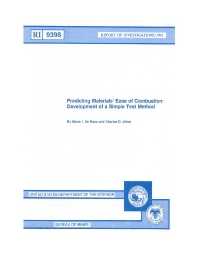Mining Publication: Predicting Materials' Ease of Combustion: Development of a Simple Test Method
Original creation date: January 1992
The U.S. Bureau of Mines conducted experiments for predicting materials' ease of combustion (smoldering onset, smoldering, flaming, and decomposition rates) by means of submicrometer smoke particle characteristics for the development of a simple test method. The experiments were carried out in an approximately 20-L furnace, with a 10-L/min airflow through the furnace for a 14-min duration, and set furnace temperatures of 150, 250, and 1,000 deg C. The variables studied as a function of time were the onset time of smoke particles, time and duration of maximum smoke particle generation, average concentration of smoke particles, and particles' average diameter, mass weight loss, and furnace temperatures. Results show that the onset time of smoke particles is predictive of materials' ease of smoldering, and the time of maximum smoke particle generation and its duration, coupled with mass weight loss, are predictive of materials' ease of smoldering and flaming (depending on the experimental temperatures), and decomposition rates.
Authors: MI DeRosa, CD Litton
Report of Investigations - January 1992
NIOSHTIC2 Number: 10011117
U.S. Department of the Interior, Bureau of Mines, Report of Investigations 9398, 1992:1-9
See Also
- The Availability of Primary Copper in Market Economy Countries: A Minerals Availability Appraisal
- A Century of Bureau of Mines/NIOSH Explosives Research
- Coal-Dust Explosion Tests in the Experimental Mine 1919 to 1924, Inclusive
- History of the Mining Program
- NIOSH Mining Update - New Publications 1995-96
- Pressure Monitoring and Observed Effects of Mining at the Oak Grove, AL, Coalbed Degasification Pattern
- Proceedings of Thru-The-Earth Electromagnetics Workshop
- Propagation of EM Signals in Underground Mines
- Update on the Continuing Functions of the Former US Bureau of Mines
- USBM Health and Safety Legacy Continues Under NIOSH
- Content source: National Institute for Occupational Safety and Health, Mining Program


 ShareCompartir
ShareCompartir
